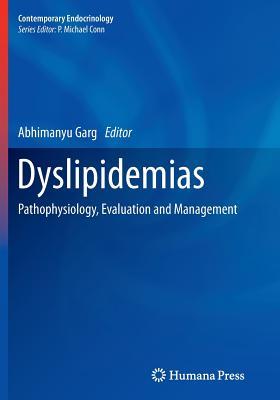Read online Dyslipidemias: Pathophysiology, Evaluation and Management - Abhimanyu Garg | PDF
Related searches:
Dyslipidemia - Endocrine and Metabolic Disorders - Merck Manuals
Dyslipidemias: Pathophysiology, Evaluation and Management
Pathophysiology, diagnosis, and management of dyslipidemia
Dyslipidemias - Pathophysiology, Evaluation and Management
Pathophysiology of dyslipidemia and increased cardiovascular
Pathophysiology, Diagnosis, and Management of Dyslipidemia
Pathophysiology of Dyslipidemia and its Management by PCSK9
Dyslipidemia and Its Role in the Pathogenesis of Atherosclerotic
Dyslipidemias: Pathophysiology, evaluation and management
Dyslipidemia: Causes, symptoms, and treatment
Pathophysiology and types of dyslipidemia in PCOS: Trends in
Pathophysiology of Diabetes and Dyslipidemia: New
Here, we review the types and pathophysiology of dyslipidemia associated with pcos and its related conditions.
Dyslipidemias: pathophysiology, evaluation and management provides a wealth of general and detailed guidelines for the clinical evaluation and management of lipid disorders in adults and children.
Sep 1, 2018 accumulating clinical evidence has suggested serum triglyceride (tg) is a leading predictor of atherosclerotic cardiovascular disease,.
May 17, 2018 blood lipids are fatty substances, such as triglycerides and cholesterol. When a person's levels are too high or low, they have dyslipidemia.
Low hdl-c phenotype and elevated plasma tg levels) in obesity is close to that previously described in diabetic subjects. Briefly, obesity is accompanied by an overproduction of vldl by the liver due to the high flux of nonesterified fatty acids (nefa) from adipose tissue to the liver.
Dyslipidemia is elevation of plasma cholesterol, triglycerides (tgs), or both, or a low hdl cholesterol level that contributes to the development of atherosclerosis. Diagnosis is by measuring plasma levels of total cholesterol, tgs, and individual lipoproteins.
In addition, dyslipidemia is highly prevalent in children with nonalcoholic fatty liver disease and may play a role in its pathophysiology.
Cardiovascular disease is one of the major causes of morbidity and mortality in patients with systemic lupus erythematosus (sle). Accelerated atherosclerosis is related to traditional (age, hypertension, diabetes mellitus, dyslipidemia, obesity, smoking, and positive family history) and non-traditio.
May 1, 2018 lipids (fats) are important component of the living cells. However, high levels can increase your risk of getting a heart attack or heart disease.
The dyslipidemias, mainly hypercholesterolemia, hypertriglyceridemia and low- plasma hdl cholesterol, among hiv-infected patients in the pre- and post- haart.
N2 - hyperlipidemia may be caused or exacerbated by many conditions including pharmacotherapy.
Pathophysiology, diagnosis, and management of dyslipidemia atherosclerosis is a systemic diffuse disease that may manifest as an anglographically localized coronary, cerebral, mesenteric, renal, and/or peripheral arterial stenosis or as diffuse atherosclerosis.
Jan 18, 2017 many patients with type 2 diabetes mellitus are characterized by a typical dyslipidemia.
Sep 9, 2018 dyslipidemia is a disease of abnormal lipid levels in the blood that contributes to the atherosclerotic process.
We will focus on the treatment of dyslipidemia in patients with and without established coronary artery disease.
Ox-ldl undergoes phagocytosis by macrophages (and vsmcs) to generate foam cells. Insufficient clearance of apoptotic foam and inflammatory cells causes.
Learn vocabulary, terms, and more with flashcards, games, and other study tools.
Dyslipidemias: pathophysiology, evaluation and management provides a wealth of general and detailed guidelines for the clinical evaluation and management.
Dyslipidemias: pathophysiology, evaluation and managementprovides a wealth of general and detailed guidelines for the clinical evaluation and management of lipid disorders in adults and children. Covering the full range of common through rare lipid disorders, this timely resource offers targeted, practical information for all clinicians who care for patients with dyslipidemias, including general internists, pediatric and adult endocrinologists, pediatricians, lipidologists, cardiologists,.
Pathophysiology dyslipidemia may have pathophysiological components that are genetic, environ-mental, or both. 1 genetic errors of cholesterol synthesis regulation, hepatic cholesterol metabolism, cell membrane receptor function, and others are recognized, yet poorly understood.
Although the pathophysiology of diabetic dyslipidaemia is not fully understood, the insulin resistance and relative insulin deficiency observed in patients with type 2 diabetes are likely to contribute to these lipid changes, as insulin plays an important role in regulating lipid metabolism.
Dyslipidemias: pathophysiology, evaluation and management provides a wealth of general and detailed guidelines for the clinical evaluation and management of lipid disorders in adults and children. Covering the full range of common through rare lipid disorders, this timely resource offers targeted, practical information for all clinicians who care for patients with dyslipidemias, including general internists, pediatric and adult endocrinologists, pediatricians, lipidologists, cardiologists.


Post Your Comments: